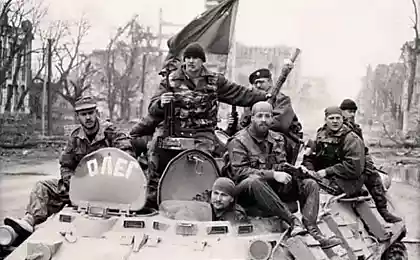950
What were drinking in the USSR (27 photos)
Kharkov 1924-th year. Tea Room. I drank and rolled. No Lipton bottled.
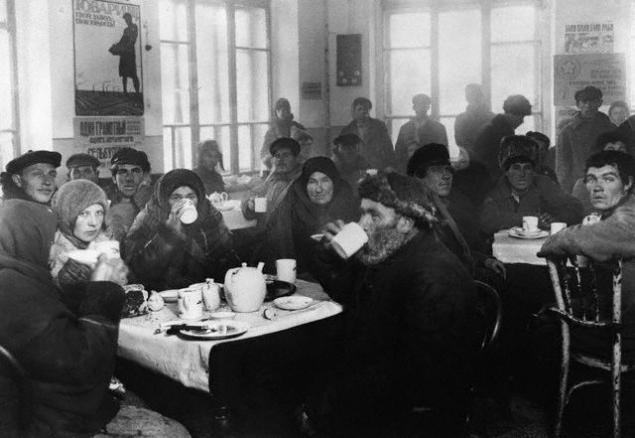
1952 Year. School canteen. No packaged juices and kefirchik.
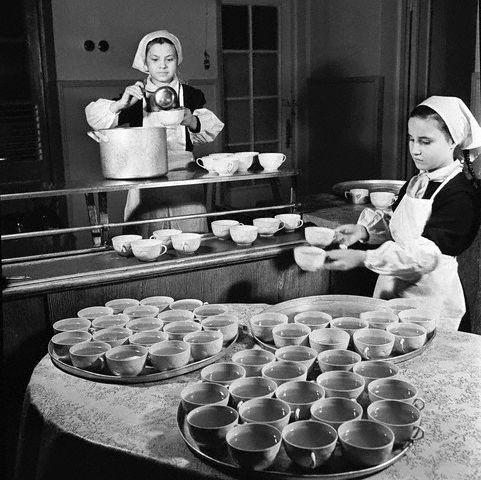
1955 Year. The only institution of automatic sale of beer under the name "Automatic". The idea is taken from the Americans. The picture shows the first day of the year after the repair.
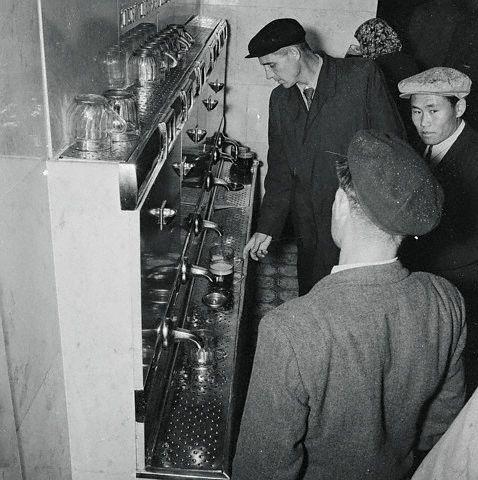
Moscow, 1959-th year. Khrushchev and Nixon (at the time vice-president) at the booth of Pepsi at the American National Exhibition in Sokolniki. On the same day there was a famous dispute in the kitchen. In America, this debate was widely publicized, we - no. Nixon told how cool to have a dishwasher, how many goods in supermarkets. All of this was shot on color videotape (super technology at the time). It is believed that Nixon so well made at that meeting, that helped him to become one of the presidential candidates for next year (and after 10 years, and the president).

In the 60th went terrible fashion for all machines. The whole world then dreamed of robots, we dreamed about automated trading. The venture failed in a sense because that does not take into account the Soviet reality. For example, when the vending machine potato pours you a rotten potatoes, they do not want to use one. Still, when it is possible to delve into the earthy container, finding a few relatively strong vegetables, this is not only the hope for a delicious meal, but training fighting qualities. Automatic survived only those who were given the same quality product - selling soda. Yet sometimes met vending sunflower oil. Survived only soda.
1961 d. ENEA. Nevertheless, before we deal with any excesses did not lag behind in the graphics and the aesthetic development of the West.

1965 d. Irkutsk. Of these barrels traded milk and kvass. Very tenacious model proved.

1966, d. Khabarovsk. Nothing has changed.

1968 d. If for the American actress Faye Dunaway and her friend Jerry Schatzberg on GUM did not run an American photographer, we could never find out what our beautiful machines in the photo 1961 ENEA were red with a beautiful color pattern on the glass.

In 1972, Pepsi-Cola reached an agreement with the Soviet government that will be pouring Pepsi "from concentrate and technology company PepsiCo," and the Soviet Union in return will be able to export vodka "Stolichnaya».
1974, d. Some boarding house for foreigners. Peas "Globe" on the top right. I have such a bank is not open still lies - all think: pizdanet or not? In any case, keep to roll up in the pack away from the books. Open too scared - suddenly I choke?
From the right edge near the cone scales visible for sale juice. Blank, however. It was not in the habit of drinking the juices of the USSR out of the refrigerator, do not vyebyvaetsya one. The saleswoman opened the three-liter jar, pour it into a cone. And then - the glasses. I was a child has found such cones in our vegetable on Travel Shokalski. When I saw your favorite apple juice from such a cone, some bastard've stole my bike "Kama" waiting room of the store, never forget.
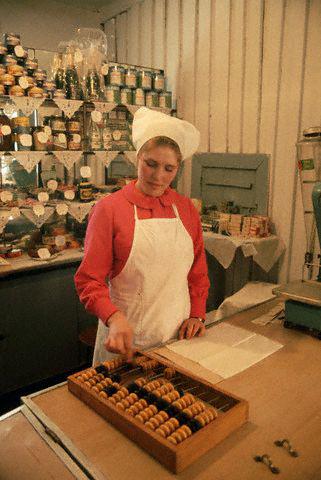
1982 d. Selection of booze in the dining car Trans-Siberian train. For some reason, many foreigners have a fixed idea to pass on the Trans-Siberian. Apparently, the idea that you can not get out of the week, riding the train, it seems magical.
Please note that the apparent abundance. No fine dry red wines. No XO and VSOP. However, even ten years after this picture was taken, the author is quite satisfied with port wine Agdam.

1983rd. The worm consumerism settled in naive and pure souls Rus. However, a bottle, a young man should be returned, someone said. He drank, enjoyed lukewarm, return packaging. It will be taken back to the factory.

Of the late 'carbonated machines. " Degradation of just such manifestations and visible. Instead of elegant forms - metal sheets rather beautiful inscriptions - primitive army stencil.
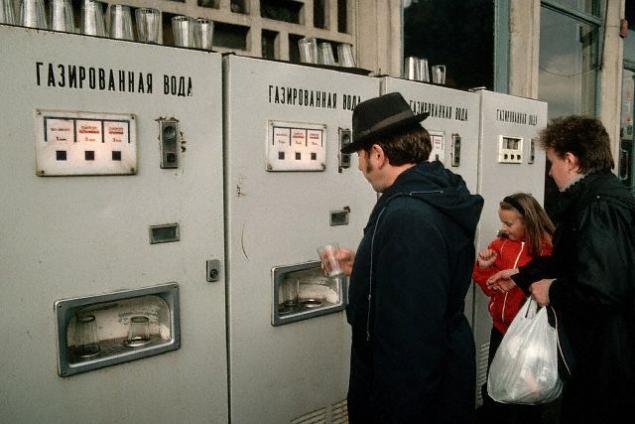
1986 d. Kvasok which is not popyrivaet in a sock. About him only memories, he was good. He was not good. Firstly, it was acidic, and secondly, it was diluted godlessly.
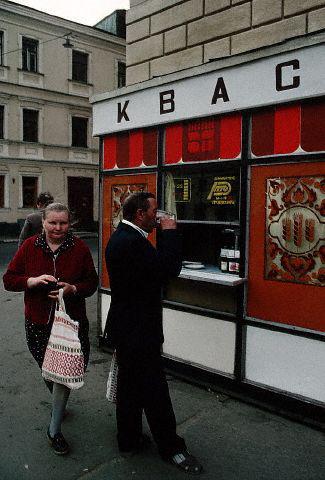
1986 d. The same kiosk with Pepsi, but the color photo. By the way, if someone thinks that in a kiosk selling Pepsi always been Pepsi, he is deeply mistaken.

The stores usually sell was "Pinocchio" or "Bell". "Baikal" or "Tarragon" is not always sold. A Pepsi when exhibited in any supermarket, he was taken to the reserve - a birthday, for example, then put.
1987, d. My aunt sells greens on the window of a dairy shop. Behind the glass visible cashier. The ones which had come well prepared - know all the prices, quantity of goods and the number of departments.

1987, d. Volgograd. In the American archives this photo is accompanied by a commentary century: «A woman on a street in Volgograd sells some sort of liquid for the invalids of the Great Patriotic War (the Soviet name for World War II).» Apparently, the same in the 87th and translated the inscription from the barrel, even when it was not to ask anyone that disabled war service out of turn. By the way, these inscriptions - the only documented the recognition that there is a queue in the USSR.

1987, d. Beauty. By the way, in those days there was no fighting merchandisers, there was no POS materials, no hanging on the shelf wobblers. No one would be and it never occurred to distribute free probnichki. If the store were given an inflatable ball with the logo of Pepsi, he considered it an honor. And exhibited in the display case and sincerely for free.
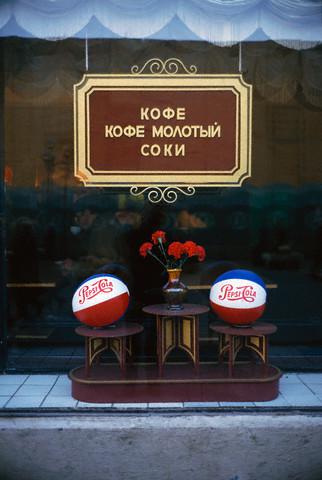
1987, d. Sell Zhigulevskoye bottled.

1990 d. Pepsi vending machine in the subway. Rare copy. Here machines that are on the right, everywhere in the center met - they sold the newspaper "Pravda", "Izvestia", "Moscow News". By the way, on all machines with soda (and play well) always had the inscription "Please! Commemorative coins are not bent and let down. " With bent is clear, and you can not drop the jubilee, because they are different from other coins of the same nominal weight and sometimes size.

1990 d. Sturm.
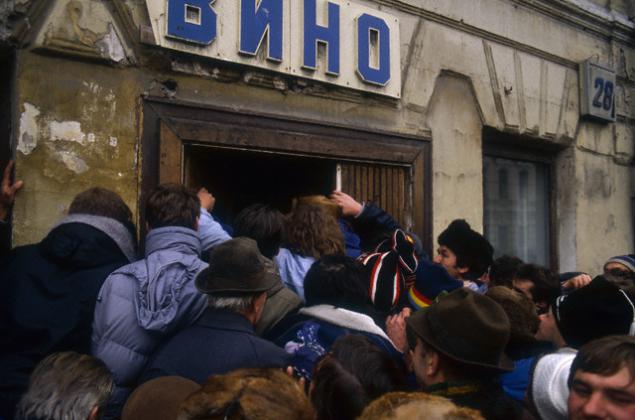
1990 d. For vodka go with your empties - in exchange. Judging by the form of the window, it's the red house on the street builders.

1991 d. There is a timid attempt to give them a merry look.
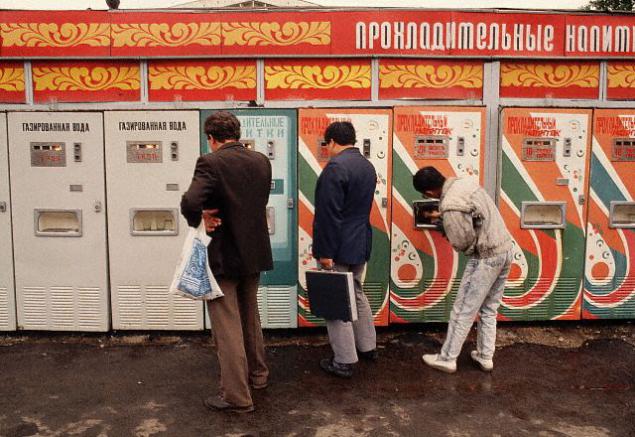
1991 d. Veteran drinking soda pop. On average machine someone has scratched logo "Depeche fashion." Glasses have always shared. Fit, wash it in the machine, then you substitute a nozzle. Fastidiously aesthetes carried a folding glasses that were a feature shape in the process. Photo is good because then all the details of characteristic and recognizable. And Payphone polubudka and lamp Zaporozhets.

1991 d. Str. Gorky. On the shelves - three-liter jar with juice. The line is clearly not for them.
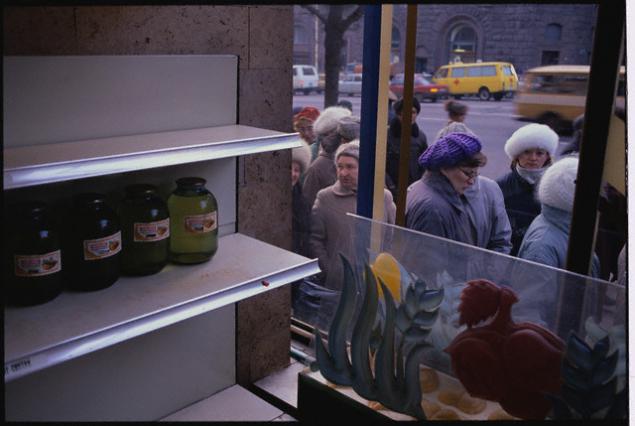
Until 1991, the American photographer walked the same routes. Almost every picture you can recognize - it's on Tverskaya Street, is on Herzen, is near the Grand Theatre, this hotel from Moscow. And then it was all you can (more on this will be a separate selection).
Recent history.
1992, d. Near Kiev. This is not the Soviet Union, just the way I had to. Man posing for American photographer, voting bottle of vodka, to change it into gasoline. It seems to me that bottle gave the photographer. Nevertheless, a bottle of vodka has long been a kind of currency. But in the mid-nineties, all the plumbing suddenly stopped taking the bottle as payment, because there are not fools - vodka sold everywhere, and it is known how much it costs. Therefore, all the money went. Bottle today give only doctors and teachers, and the brandy.

1993rd. With the collapse of the Union is somehow lost interest in Pepsi. Because there was a Coca. First, even put kiosks as Coke cans.

Sometimes even the customer care - do visors similarity of the window.

Hence

1952 Year. School canteen. No packaged juices and kefirchik.

1955 Year. The only institution of automatic sale of beer under the name "Automatic". The idea is taken from the Americans. The picture shows the first day of the year after the repair.

Moscow, 1959-th year. Khrushchev and Nixon (at the time vice-president) at the booth of Pepsi at the American National Exhibition in Sokolniki. On the same day there was a famous dispute in the kitchen. In America, this debate was widely publicized, we - no. Nixon told how cool to have a dishwasher, how many goods in supermarkets. All of this was shot on color videotape (super technology at the time). It is believed that Nixon so well made at that meeting, that helped him to become one of the presidential candidates for next year (and after 10 years, and the president).

In the 60th went terrible fashion for all machines. The whole world then dreamed of robots, we dreamed about automated trading. The venture failed in a sense because that does not take into account the Soviet reality. For example, when the vending machine potato pours you a rotten potatoes, they do not want to use one. Still, when it is possible to delve into the earthy container, finding a few relatively strong vegetables, this is not only the hope for a delicious meal, but training fighting qualities. Automatic survived only those who were given the same quality product - selling soda. Yet sometimes met vending sunflower oil. Survived only soda.
1961 d. ENEA. Nevertheless, before we deal with any excesses did not lag behind in the graphics and the aesthetic development of the West.

1965 d. Irkutsk. Of these barrels traded milk and kvass. Very tenacious model proved.

1966, d. Khabarovsk. Nothing has changed.

1968 d. If for the American actress Faye Dunaway and her friend Jerry Schatzberg on GUM did not run an American photographer, we could never find out what our beautiful machines in the photo 1961 ENEA were red with a beautiful color pattern on the glass.

In 1972, Pepsi-Cola reached an agreement with the Soviet government that will be pouring Pepsi "from concentrate and technology company PepsiCo," and the Soviet Union in return will be able to export vodka "Stolichnaya».
1974, d. Some boarding house for foreigners. Peas "Globe" on the top right. I have such a bank is not open still lies - all think: pizdanet or not? In any case, keep to roll up in the pack away from the books. Open too scared - suddenly I choke?
From the right edge near the cone scales visible for sale juice. Blank, however. It was not in the habit of drinking the juices of the USSR out of the refrigerator, do not vyebyvaetsya one. The saleswoman opened the three-liter jar, pour it into a cone. And then - the glasses. I was a child has found such cones in our vegetable on Travel Shokalski. When I saw your favorite apple juice from such a cone, some bastard've stole my bike "Kama" waiting room of the store, never forget.

1982 d. Selection of booze in the dining car Trans-Siberian train. For some reason, many foreigners have a fixed idea to pass on the Trans-Siberian. Apparently, the idea that you can not get out of the week, riding the train, it seems magical.
Please note that the apparent abundance. No fine dry red wines. No XO and VSOP. However, even ten years after this picture was taken, the author is quite satisfied with port wine Agdam.

1983rd. The worm consumerism settled in naive and pure souls Rus. However, a bottle, a young man should be returned, someone said. He drank, enjoyed lukewarm, return packaging. It will be taken back to the factory.

Of the late 'carbonated machines. " Degradation of just such manifestations and visible. Instead of elegant forms - metal sheets rather beautiful inscriptions - primitive army stencil.

1986 d. Kvasok which is not popyrivaet in a sock. About him only memories, he was good. He was not good. Firstly, it was acidic, and secondly, it was diluted godlessly.

1986 d. The same kiosk with Pepsi, but the color photo. By the way, if someone thinks that in a kiosk selling Pepsi always been Pepsi, he is deeply mistaken.

The stores usually sell was "Pinocchio" or "Bell". "Baikal" or "Tarragon" is not always sold. A Pepsi when exhibited in any supermarket, he was taken to the reserve - a birthday, for example, then put.
1987, d. My aunt sells greens on the window of a dairy shop. Behind the glass visible cashier. The ones which had come well prepared - know all the prices, quantity of goods and the number of departments.

1987, d. Volgograd. In the American archives this photo is accompanied by a commentary century: «A woman on a street in Volgograd sells some sort of liquid for the invalids of the Great Patriotic War (the Soviet name for World War II).» Apparently, the same in the 87th and translated the inscription from the barrel, even when it was not to ask anyone that disabled war service out of turn. By the way, these inscriptions - the only documented the recognition that there is a queue in the USSR.

1987, d. Beauty. By the way, in those days there was no fighting merchandisers, there was no POS materials, no hanging on the shelf wobblers. No one would be and it never occurred to distribute free probnichki. If the store were given an inflatable ball with the logo of Pepsi, he considered it an honor. And exhibited in the display case and sincerely for free.

1987, d. Sell Zhigulevskoye bottled.

1990 d. Pepsi vending machine in the subway. Rare copy. Here machines that are on the right, everywhere in the center met - they sold the newspaper "Pravda", "Izvestia", "Moscow News". By the way, on all machines with soda (and play well) always had the inscription "Please! Commemorative coins are not bent and let down. " With bent is clear, and you can not drop the jubilee, because they are different from other coins of the same nominal weight and sometimes size.

1990 d. Sturm.

1990 d. For vodka go with your empties - in exchange. Judging by the form of the window, it's the red house on the street builders.

1991 d. There is a timid attempt to give them a merry look.

1991 d. Veteran drinking soda pop. On average machine someone has scratched logo "Depeche fashion." Glasses have always shared. Fit, wash it in the machine, then you substitute a nozzle. Fastidiously aesthetes carried a folding glasses that were a feature shape in the process. Photo is good because then all the details of characteristic and recognizable. And Payphone polubudka and lamp Zaporozhets.

1991 d. Str. Gorky. On the shelves - three-liter jar with juice. The line is clearly not for them.

Until 1991, the American photographer walked the same routes. Almost every picture you can recognize - it's on Tverskaya Street, is on Herzen, is near the Grand Theatre, this hotel from Moscow. And then it was all you can (more on this will be a separate selection).
Recent history.
1992, d. Near Kiev. This is not the Soviet Union, just the way I had to. Man posing for American photographer, voting bottle of vodka, to change it into gasoline. It seems to me that bottle gave the photographer. Nevertheless, a bottle of vodka has long been a kind of currency. But in the mid-nineties, all the plumbing suddenly stopped taking the bottle as payment, because there are not fools - vodka sold everywhere, and it is known how much it costs. Therefore, all the money went. Bottle today give only doctors and teachers, and the brandy.

1993rd. With the collapse of the Union is somehow lost interest in Pepsi. Because there was a Coca. First, even put kiosks as Coke cans.

Sometimes even the customer care - do visors similarity of the window.

Hence

















